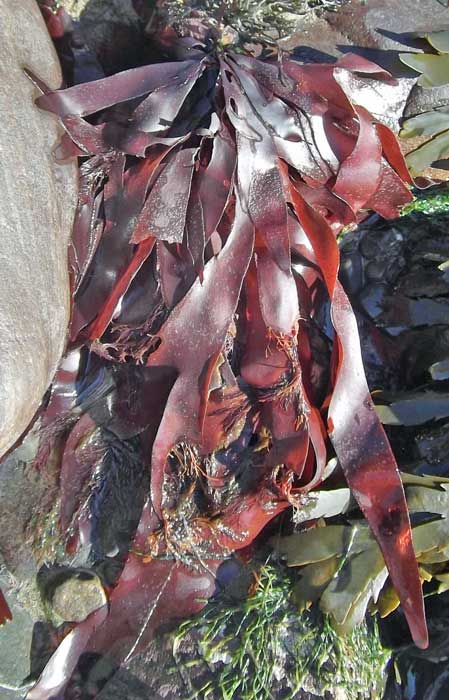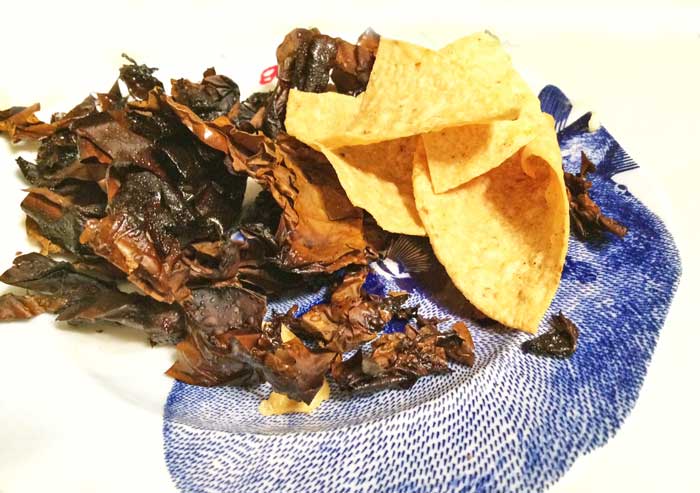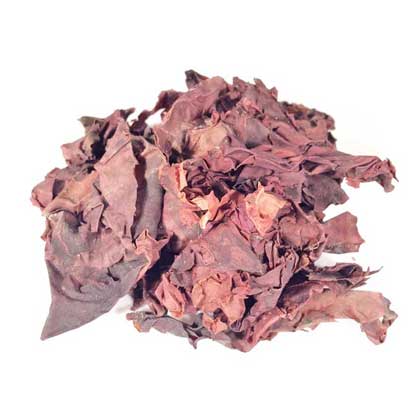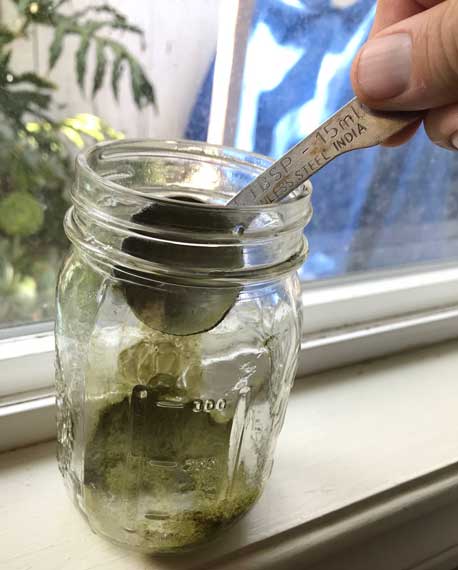updated: 4-4-2020
What is dulse?
Dulse is a red algae that grows along the northern coastlines of the Pacific and Atlantic Ocean. It attaches to rocks in the inter-tidal zone and lives comfortably among the breaking waves.
Europeans have been eating this ancient sea vegetable for the past 1,500 years. Early farmers in Iceland and Ireland harvested strands of dulse from their rocky shorelines and garnished otherwise bland meals with this nutritious red seaweed (Indergaard, 1991).
Whether those early foragers knew it or not, that primitive red garnish was providing them with the equivalent of a multi-vitamin.
Modern-day food fanatics are just beginning to appreciate the many health benefits of dulse.
We now know this ancient red algae is densely packed with vitamins, minerals, protein, antioxidants and fiber.
In this article, I discuss the following topics:
- the cultural history of dulse
- the health benefits of this sea vegetable
- my daily superfood, powder drink
Scroll down to read entire article, or click on a topic above to jump to that section.

photo by: Cwmhiraeth
Dulse use a short stem to attach to rocks. Broad, red-colored leaves flow out into the breaking waves.
Quick scientific background on dulse
The scientific name for Atlantic dulse is Palmaria palmata. As a member of the red algae division, dulse is currently grouped within the Archaeplastida. The Archaeplastids are a sub-group of eukaryotes, which also includes the land plants.
(Humor me here…I’m a biology nerd.)
Red algae use red pigment molecules in their chloroplasts to help them perform photosynthesis. This allows them to produce their own energy (and gives them their distinctive red color).
These plant-like seaweeds have been creeping around our planet for a long time. In fact, red algae are one of the oldest groups of eukaryotic creatures. A 1.2 billion year old fossil found in Canada is thought to be a very early version of a red algae. (Butterfield, 2000)
This deep history tells us that red algae are very successful at living on earth. They’ve been around awhile and avoided extinction.
So…they must be doing something right.
Share this dulse page with friends, click on an icon below.
Brief history of humans eating red algae
Historical records indicate that the Chinese, Japanese and Europeans have been eating red algae for the past 2,000 years.
In 600 BC, a Chinese author named Sze Teu wrote a book describing how seaweed was prepared as special gifts for kings. During the Greek and Roman empire – seaweeds growing in the Mediterranean Sea were routinely used as medicine. In fact, as early as 100 BC, records indicate that ancient Greeks used a species of red algae to treat infections from parasitic worms.
In Japan, by approximately 800 AD, at least 6 types of seaweed were commonly used in traditional Japanese meals.
When did human first begin to eat dulse?
The first recorded use of dulse dates back to 961 AD in Iceland. According to the Icelandic Sagas, sol was a highly valued food source. Sol is the old Norse word for dulse.
Dulse was so commonly eaten that this red algae made an appearance in Icelandic legal documents. Iceland’s oldest law-book, written in 1150 AD, mentions that it is:
…perfectly legal to collect and eat another man’s dulse when traveling across his property.
THE USES OF SEAWEEDS IN ICELAND S. V. HALLSSON
At some point, the habit of eating dulse spread westward across Europe.
Records from 500 AD indicate Christian monks in Ireland and Scotland were regularly eating and enjoying dulse. 1,400 years ago, monks following St. Columba harvested this nutritious red algae from the rocky shoreline of the British Isles. St. Columba is the Irish abbot credited with spreading Christianity into Scotland (Indergaard, 1991).
Interestingly, the name dulse is derived from the old Gaelic word dillisk.
So, in summary. . .
People have been eating red algae for a long time.
And, most importantly, if you find yourself wandering across a private beach in Iceland, feel free to snack on the local dulse.

Illustration by J.R. Skelton
St. Columba followed by his monks.
According to legend, this Irish abbot enjoyed eating the dulse while walking through Scotland in 500 A.D.
Preparing dulse
Dulse can be prepared fresh, fried or else dried into flakes and sprinkled on salads and soups. When eaten fresh, dulse has a pleasant texture. Its slightly chewy, but certainly easy to eat.
I order my whole dulse and dried dulse flakes from a Maine seaweed company named VitaminSea.
My favorite preparation is fried. I lightly oil a pan, then heat up flattened strips of dulse for 3-4 minutes, stirring the strips around regularly.
This pan-fry treatment crisps up the dulse and makes it delicious.
Once crispy, you can put together a DLT – dulse, lettuce and tomato.

I lightly fried this dulse in oil. The chewy texture is now replaced with a crisp, bacon-like texture.
Why would you want to go through the trouble of preparing and eating seaweed?
Well, as mentioned above, dulse is packed full of nutrients.
Below – we’ll describe the various health benefits of dulse.

Dried leaves of applewood smoked dulse.
The many health benefits of eating dulse.
Minerals
Dulse is packed with many of the minerals that humans need to consume every day. A single serving of dulse provides us a rich supply of Iron, Potassium, Calcium, Chromium and Magnesium.
Calcium, iron and magnesium all contribute to robust bone density. Maintaining bone density becomes more important as we get older and negotiate osteoporosis. We need plenty of iron to keep our muscles and red blood cells happy. Potassium is a well-known vaso-dilator, which means this mineral helps to reduce the strain on our arteries caused by high blood pressure.
Vitamins
Dulse is a rich source of Vitamin B-12, Vitamin A, Vitamin B6 and Vitamin C.
Vitamin B-12 is mostly found in animal-based foods. So, if you’re vegan, you may rely on dulse as your B-12 source. Vitamin A helps build and maintain teeth, bones, skin and soft tissue. Research has also shown Vitamin A slows the development of cataracts in our eyes. Vitamin C is a key component of our immune system. It also helps us with our white blood cell count, collagen production and acts as an antioxidant.
Omega-3 and Omega-6
In general, red algae are enriched for polyunsaturated fatty acids (PUFAs).
Dulse contains 2 of the more interesting PUFAs: omega-3 and omega-6. PUFAs are fatty acids that contain more than one double bond in their backbone structure. The actions of omega-3 and omega-6 in our body are best characterized by their interactions with each other. They’re difficult to understand when considered separately. That said, these omega acids are thought to help regulate multiple body functions: including blood clotting, arthritis, blood pressure as well as the proper functioning of the brain and nervous system.
Protein
I was surprised when I learned that a 3.5 ounce serving of fresh dulse provides about 21.5 grams of protein. 21 grams is a whopping 43% of the daily requirement of protein, as set by the FDA. So, eating dulse is a nice way to compliment the protein you may be getting from meat and land-based vegetables.
Fiber
As you might expect from a seaweed, dulse contains a good amount of dietary fiber. You get 16 grams of fiber in a 2 ounce serving of dulse. Dietary fiber helps us regulate our digestive process. This fiber bulks up our stool and, in general, facilitates a better experience in the bathroom.
A word of caution regarding iodine
Like most seaweeds, dulse also contains high amounts of iodine. Iodine is an essential mineral for the thyroid. We need iodine for the proper functioning of our thyroid gland.
However, if you eat too much dulse – you can possibly upset the balance of hormones in your thyroid. So, like all things, eat dulse in moderation. People suffering from hyperthyroidism or hypothyroidism should probably avoid eating dulse altogether.
If you have any questions regarding dulse and your personal iodine intake levels, consult a trained physician or dietician.
One more thing…
For the past three years, we’ve been drinking a green plant powder mix that combines high fiber and lots of superfood nutrients.
The fiber part curbs the appetite throughout the day.
The superfood, green plant powder part fills the body with vitamins, minerals, digestive enzymes, antioxidants and other phyto-nutrients.
Most importantly, this drink is for people who don’t want to spend too much time preparing healthy foods.
For this green powder concoction, we just add powder to water, stir and drink!
References
- Indergaard, M. and Minsaas, J. 1991. 2 “Animal and human nutrition.” in Guiry, M.D. and Blunden, G. 1991. Seaweed Resources in Europe: Uses and Potential. John Wiley & Sons. ISBN 0-471-92947-6
- Butterfield (2000). “Bangiomorpha pubescens n. gen., n. sp.: implications for the evolution of sex, multicellularity, and the Mesoproterozoic/Neoproterozoic radiation of eukaryotes”. Paleobiology. 26 (3): 386–404. doi:10.1666/0094-8373(2000) ISSN 0094-8373.
Click below to share this dulse article with friends.

